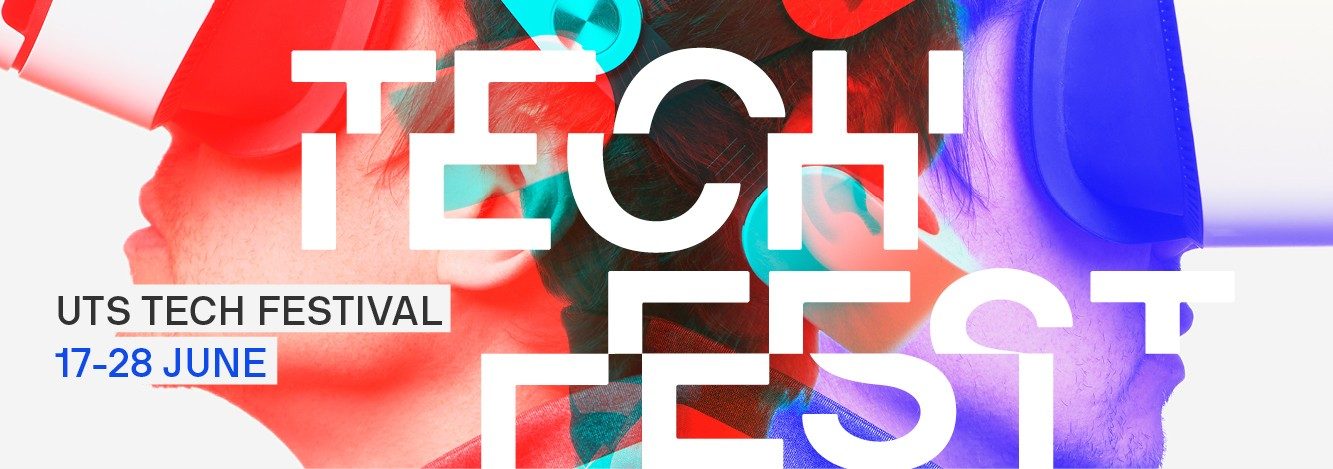
About
UTS Tech Festival (17 – 28 June, 2024) is a two weeks festival of events, showcases, hackathons, workshops, masterclasses, seminars, competitions, industry-student engagement and much more! Our goal is to bring together students, academics and industry to foster learning, inspiration, share ideas and promote innovation.
Come along to the UTS Robotics Showcase which is part of the UTS Tech Festival 2024, to discover great projects!
Venue:
UTS Faculty of Engineering and Information Technology
Broadway, Ultimo NSW 2007, Australia
Date and Time:
Wednesday, June 28, 2024, 3.30pm – 7.00pm
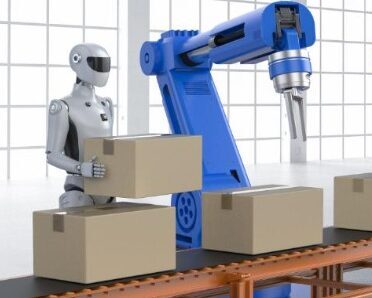
Program
Organising Committee

Dr Marc Carmichael
Senior Lecturer

Jason Do
Coodinator, Student Engagement

Sarah Rodriguez
Student Engagement Officer

Sheila Sutjipto
Lecturer
Project List

UTS Rocketry - Ground Station and Launch Controller
Timothy Gibson, Samuel Cain-Copnall, Robin Biskupic, Denisse Fernandez
Room 400, Pod 1
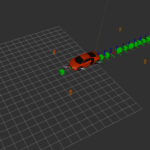
Self-Driving Pursuit Algorithm on a Simulated Track
Nathan Turner
Room 400, Pod 2
A ros2 package designed to automatically drive a simulated car around a simulated track using cubic splines to achieve smooth driving.

LED Fan Display
Sebastian Smith
Room 400, Pod 3

Human Detection using Sensors on a Drone
Anika Roth
Room 400, Pod 4
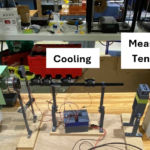
Plastic Filament Extruder for 3D Printing
Jeremy Chu, Duc Do, Jonathan Harris, Mark Lu
Room 400, Pod 5
UTS ProtoSpace and FEIT members require a filament spooler intended to use existing extruding technology to create high-quality 3D printing filament from recycled 3D prints and experimental materials. The system will guarantee a uniform filament diameter consistency of 1.75 mm ±0.3 mm. It will have customizable settings for different materials, a modular design for easy installation, scalability, and simple maintenance using easily sourced and produced parts. The project’s objective is to provide a fully operational, proof-of-concept filament spooler model, detailed design documentation, and a report assessing the filament’s quality.
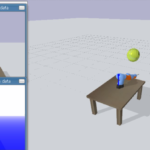
Robotic Arm Collision Avoidance
Yara Fakoua, Damian Sue, Iraklis Roussos, Morne Kruger
Room 400, Pod 6
Robots currently operate in dynamic environments and must avoid potential collisions that could cause injury or damage equipment. Therefore, we developed a collision avoidance system that uses reinforcement learning to train a robot arm to navigate safely in these dynamic environments. The approach involves utilising an RGB and depth camera with a YOLO computer vision model to locate thrown tennis balls in real-time, enabling the robot arm to avoid them.
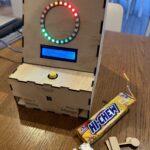
Cyclone Arcade Game
Noah Yom-Tov
Room 400, Pod 7
An LED based game designed to test your reaction time. Make it through 5 rounds of increasing difficulty and win a prize! Do you have what it takes to win?
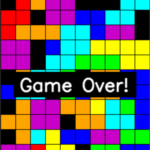
Tetris Master 3000
Christopher Gilmore, Johnson Ly, Aidan Korpar, Liam Faulkner-Hogg
Room 400, Pod 8
Our AI, the Tetris Master 3000, leverages Deep Q-Networks (DQN) and reinforcement learning to master the game of Tetris. The AI is trained on a standard 10×20 board but can still maintain high performances even on larger board sizes. The AI is rewarded for clearing lines, with higher rewards for multiple line clears, and for extending its survival time. This advanced training enables the Tetris Master 3000 to outperform any human player.

Sci-Fi Animal Helmet
Michael Lee
Room 400, Pod 9
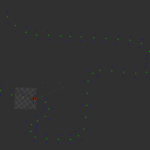
Autonomous Track Racer with Teleoperational Control
Luke Howard
Room 400, Pod 11
This project showcases the development of an autonomous track racing system using a developed ROS2 package to control a digital Audi R8. The system utilizes sensor data for real-time processing to navigate a track efficiently. The setup includes multiple ROS nodes for laser scan processing, environment replication, and user interaction. Teleoperational control is added for enhanced interactivity, allowing users to compete against the autonomous car using a controller. This addition aims to provide a dynamic and engaging experience for participants.
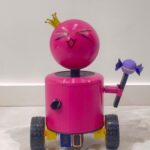
Candy King - Voice Activated Candy Dispensing Robot
Daniya Syed
Room 400, Pod 12
Introducing Candy King, your whimsical candy dispensing robot! With a simple voice command from your phone, it not only delivers your favorite sweets but also dances, drives, and brings the joy of interactive technology to your candy cravings.
Candy King’s features are divided into three subsystems: Dispensing Candy, Party Mode, and Driving. All functions are controlled through voice commands via implementation of Google Speech on a phone, which sends commands through an HC-05 Bluetooth module to the Arduino.
Created for the first-year subject “”Introduction to Mechatronics Engineering,”” this project aims to experiment with voice command.

Tunable Ideochord
Oliver Shields
Long Thinh Le
Samiul Khan
Samuel Carlton
Room 400, Pod 13
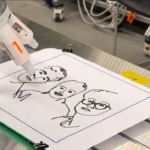
Selfie Drawing Robot
Dennis Nguyen,
Long Thinh Le,
Samuel Bloomfield,
Stewart Kelly
Room 400, Pod 14
This project presents a Selfie Drawing using the UR3 Robot arm, which serves Tracing Personal Portraits in under 3 minutes. The project specifically focused on Sketching Outline Portraits of users. Through the automated processing of images, this system simplifies the creation of “robotics art,” offering users an enjoyable and engaging experience. Users can immerse themselves in a unique experience by sitting in front of a 1080p Camera to capture a selfie portrait. Once the user is ready, our system will take a picture and process it to a .svg outline image, allowing the UR3 robot arm to draw. After finishing the artwork, the creative journey continues for the next eager customer, ready to embark on their personalized masterpiece.
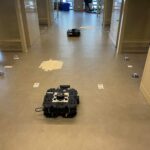
Multi-Agent Automated Turtlebot Warehouse
Brendan White, Daniel Chen, John Hunter, Liam Hogarth
Room 300, Pod 2
This automated picking system demonstrates a real-life integration of autonomous warehousing using multiple Turtlebots to complete the tasks. Utilising Robotic Operating System (ROS) the TurtleBots are able to sort their tasks, localise themselves to their surroundings, calculate an efficient path to the items and drive autonomously; all while avoiding eachother and obstacles in their environment.
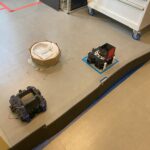
Turtlebot3 Warehousing Robots
Aidan Korpar,
Callum Power,
Kevin Biddulph,
Johnson Ly
Room 300, Pod 3
Our project utilises multiple autonomous pick and deposit warehousing robots that will travel to pick up and deposit locations based on distance and demand, whilst using dynamic obstacle avoidance to account for any interference within the working environment.

PR2
Anh Minh Tu
Room 300, Pod 4
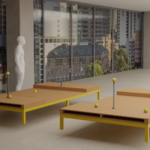
VR Engineering Lab Safety Training
Daniel Ugarte
Room 300, Pod 5
Improving engineering education through a Virtual Reality (VR) based Lab Safety Training program. Leveraging Extended Reality (XR) technologies to overhaul traditional safety training methods, this project aims to transition from passive, slide-based induction learning to an active, immersive educational experience. Unlike conventional approaches that often lead to superficial engagement and memorisation, the VR trainer plunges students into a realistic engineering lab environment where they can interact directly with equipment, identify potential hazards, and respond to emergency situations in real-time. Using 3D modelling tools like Blender, and Unity for seamless VR integration, this solution is designed to enhance understanding, retention, and practical application of safety protocols.

Carrot - The Seed-Collecting Robot
Aaditya Mishra, Amanda Yousif, Benjamin Hendry, Daniya Syed, Zain Khan
Room 301, Pod 3
Carrot- The seed-collecting robot is an autonomous transportation system designed to complete the 2024 Warman Challenge, a global design and build competition for mechanical and mechatronic engineering students.
Named after its colour resemblance to a carrot, the robot features a versatile mecanum chassis and a reliable pickup and depositing system, the robot can complete the challenge autonomously in 42 seconds. It can also be operated with a controller during the showcase, so be sure to give the challenge a shot using Carrot!
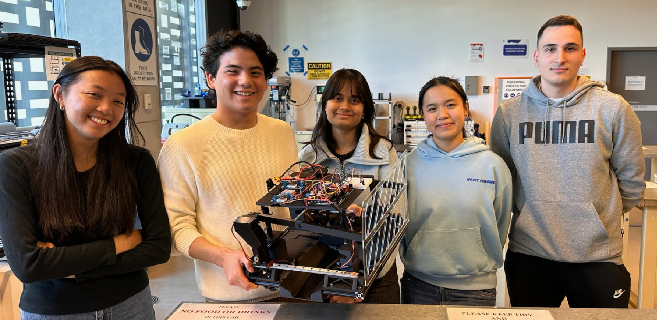
AAA Warman Project
Jessica Le,
Tom Mihalic,
Amy Zhong,
Abisha Nasim,
Aiden Lee
Room 301, Pod 4
The Warman Design and Build Challenge is a challenge where as a team of 5 we are tasked to build a reduced scale proof of concept robot. The robot must be able to collect six tennis balls from varying heights and distances from the edge of the platform then deposit in a hole at the centre of the track. Our design was chosen to help reduce the precision that would be required if we used an arm increasing the chance we have to pick up each ball. The robot will move around the track, stopping along the raised edge of the track. Allowing the arms to move towards the ball and then the arms will retract back, pushing the balls into the catchment system. After collecting the 3 balls from one side it will go to the depositing hole and open the depositing system to push the balls in the hole before repeating on the other side.

Pedro (Warman #3)
Isabelle Wilkins,
Natalia Gandera
Room 301, Pod 5
Our project is our an attempt at the Warman challenge. Inspired from various arcade claw machines, everyday desk lamps, and a personal favourite of ours, the vacuum cleaner. Post semester we continued to develop the mechatronic side of the robot by making it move from a controller.

WarMan
Sebastian Baudille,
Samuel Heinz,
Yuto Boittiaux,
Guy Smith,
Nicholas Sabatta
Room 301, Pod 6
Our project in response to the 2024 Warman Design and Build Competition uses bi-directional steering and a rotating arm with a dome lid that encapsulates the tennis balls for efficient and consistent ball collection. This is all supported by a small and light weight chassis which allows for ease of manoeuvrability. All balls collected are stored in a line along a ramp which allows for a quick and error free release. The system is activated with a single switch which then runs a pre-programed path to complete the track.

Warman Design & Build Challenge - #5
Fergus Hudson, Daniel Bell, Harry Jackson
Room 301, Pod 7

Warman Design & Build Challenge - #6
Julian Baeza, Jonah Gonzales, Xuan Kien Nguyen, Yu-Chia Chang
Room 301, Pod 8